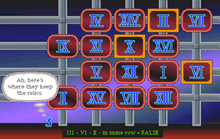3 in Three
| 3 in Three | |
|---|---|
 | |
| Developer(s) | Cliff Johnson |
| Publisher(s) |
Cinemaware Inline Design |
| Platform(s) | Mac OS |
| Release date(s) | 1989 |
| Mode(s) | Single-player |
3 in Three is a 1989 computer game by Cliff Johnson.
While bearing some similarities to his previous game, The Fool's Errand, 3 in Three brought the meta-puzzle to a new environment: inside the computer. The tale this time is of a wayward number 3, lost in the innards of the computer by a power surge. The 3 attempts to repair the damage caused by the power surge and make her way back to the spreadsheet, providing the background story for the game.
A sequel, 3's a Crowd, has been mentioned as Cliff Johnson's next planned work after The Fool and His Money.
Release Information
Unlike his earlier games, 3 in Three was never ported, but was only released for the Apple Macintosh. It was initially released by Cinemaware, which went out of business in 1991; the license was then picked up by Inline Design, which went out of business in 1995. It is now freeware and can be found on the author's website.n It includes information which allows the game to be played on Windows PCs.
Awards
3 in Three won the following awards:
- 1991 MacUser Game of the Year
- 1990 Macworld Game Hall of Fame
- 1991 Games Best Puzzle Game of the Year
Structure
The game consists of many separate sections, each of which contains one puzzle. However, unlike Fool's Errand, each section may need to be visited multiple times, as it may carry along part of the story at times when it does not contain a puzzle. Each puzzle (upon completion) places one letter in the Letter Legislature. When the entire legislature is in place, a logic puzzle (see below) is used to properly order them, at which point the endgame begins; the hints found in previous puzzles are used to complete the meta-puzzle and finish the game.
Puzzles

Unlike The Fool's Errand, the puzzles in 3 in Three are rarely old pencil-and-paper standbys like cryptograms or word searches; instead, the puzzles tend to take full advantage of the possibilities of computer administration. Some of the prominent puzzle types include:
- Lift puzzles - the 3 must navigate across a field of lifts by putting her lift and the lift to her right at the same level.
- Mesh puzzles - the 3 must change a mesh (of sizes ranging from 3x3 to 9x9) to match a given pattern.
- Missing vowels - the 3 must add missing vowels to common proverbs or homophones.
- Trapdoor puzzles - the 3 must open or close all of a set of doors; clicking on one door will toggle the open state of several others, with the exact set of doors toggled depending on the state of the door clicked. (Thus clicking on door 3 may open or close doors 1, 3, and 9 if it is open, but 3, 4, and 5 if it is closed.)
- Reordered word puzzles - the 3 must rearrange a word to spell another word in 3 clicks. Each click switches two letters; the letters switched depend on which letter is clicked and its position in the word.
- Logic puzzles - A grid of items must be rearranged to meet specific rules. (For example, a set of Roman numerals may include a rule like 'XVI is north of XIV'.)
References
| Wikimedia Commons has media related to 3 in Three. |
n Official Site, with author's information page, including download options and instructions for installation.